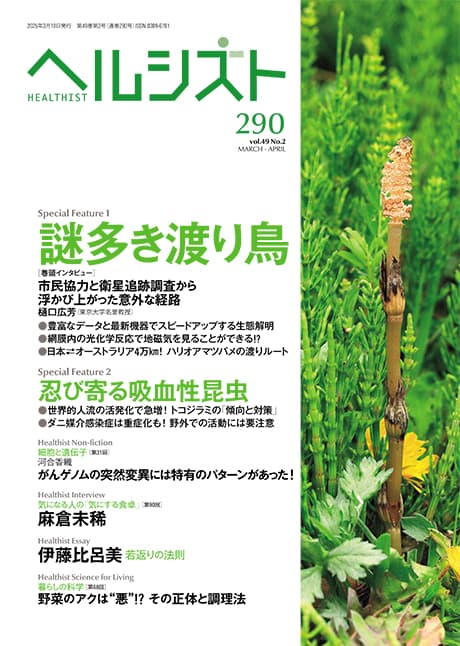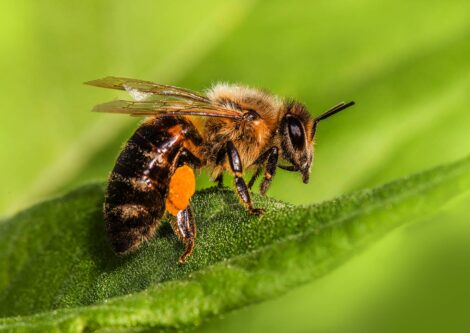Renowned for having the fastest horizontal flight speed of any migratory bird, the white-throated needletail (Hirundapus caudacutus) comes to the warm climes of Japan in spring to nest, lays its eggs, and raise its young, then migrates to Australia when autumn arrives. However, as these birds spend their lives on the wing when they are not raising their young, they are very difficult to observe, and their migratory route remained unclear. Nevertheless, scientists have now succeeded in conducting a tracking survey of white-throated needletails fitted with small recording devices, and have determined their precise migratory routes in spring and autumn. Rather than taking the shortest route, these birds make a round-trip of as much as 40,000 km between Japan and Australia, following a figure-eight pattern.
Special Feature 1 – Mysteries of Migratory Birds 40,000 km between Japan and Australia! The migratory route of the white-throated needletail
composition by Takeaki Kikuchi
One of birds’ most prominent features is that, with a handful of exceptions, they can fly. Their flying ability and the distance they can travel varies considerably from one species to another, but it would probably be fair to say that they are the most highly mobile creatures on Earth.
As the white-throated needletails introduced in this article have a particularly outstanding ability to fly, even compared with other birds, research into their distinctive ecology is progressing as part of a major project (Figure 1).
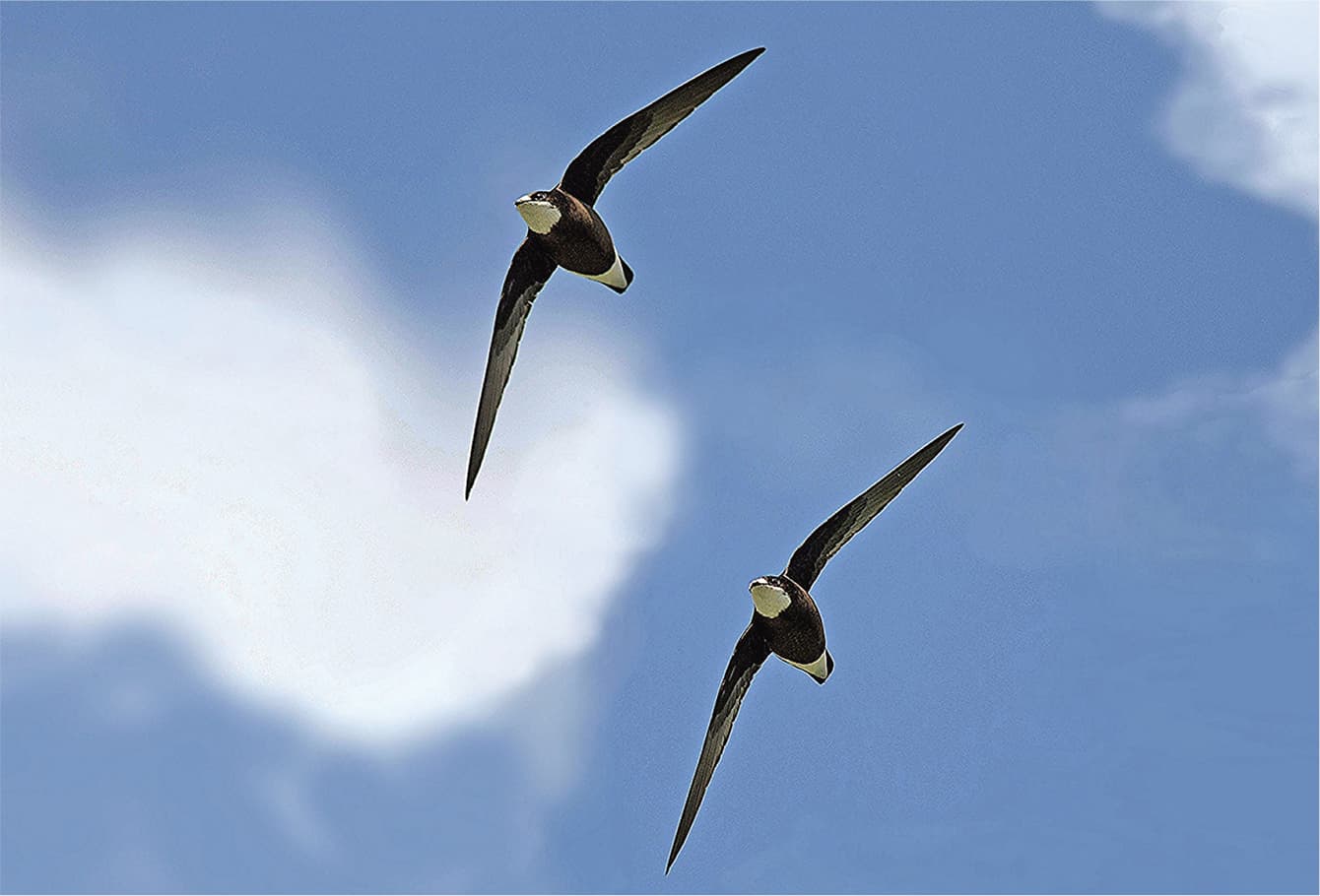
Figure 1. White-throated needletailsWhite-throated needletails are about 21 cm long and have a somewhat plump physique. Their wings are shaped like a sickle. Their tail feathers are short, with pointed tips, like needles.(Photograph: Daichi Waga)
Their precise route identified for the first time worldwide
The swift family also contains a number of other species, which are attracting attention from Western researchers as well. This is because, according to previous studies, some of these species also spend their entire lives on the wing, apart from when they are raising their young. They catch their food in midair and eat it while in flight. At night, they sleep while flying. This is the extent to which these birds have developed specifically for life in the air. One could probably say they are the most birdlike of birds.
White-throated needletails have an incredibly fast horizontal flight speed. In fact, they are listed in Guinness World Records as the bird with the fastest horizontal flight speed (170 km/h). We are currently in the process of verifying whether or not this is true, but either way, these birds undoubtedly have an astonishingly impressive ability to fly.
In Japan, the breeding grounds of white-throated needletails are mostly located in Hokkaido, with a few also confirmed to exist in northern Honshu. Their wintering spots are in Oceania, in the Southern Hemisphere, where it is summer at that time of year. In the spring and autumn migration seasons, individuals are observed in various locations during their journey. As there are birdwatchers not only in Japan, but also in countries across the globe, scientists had a fragmentary understanding of their migratory route based on information amassed from sightings in each area.
We were the first in the world to identify their precise route, publishing it in a 2021 article. It was 2015 when we embarked on a survey of their route. At one breeding ground in Hokkaido, we caught a few white-throated needletails and fitted each of them with an ultra-lightweight recording device called a geolocator, which weighs just 0.7 g or so (Figure 2). The mechanism differs from that of GPS loggers found in smartphones, but it gathers and records information about location. Equipped with a sensor that senses light levels, the device enables the recorded changes in brightness to be used to calculate sunrise, sunset, and daytime length, from which we can estimate each bird’s latitude and longitude each day.
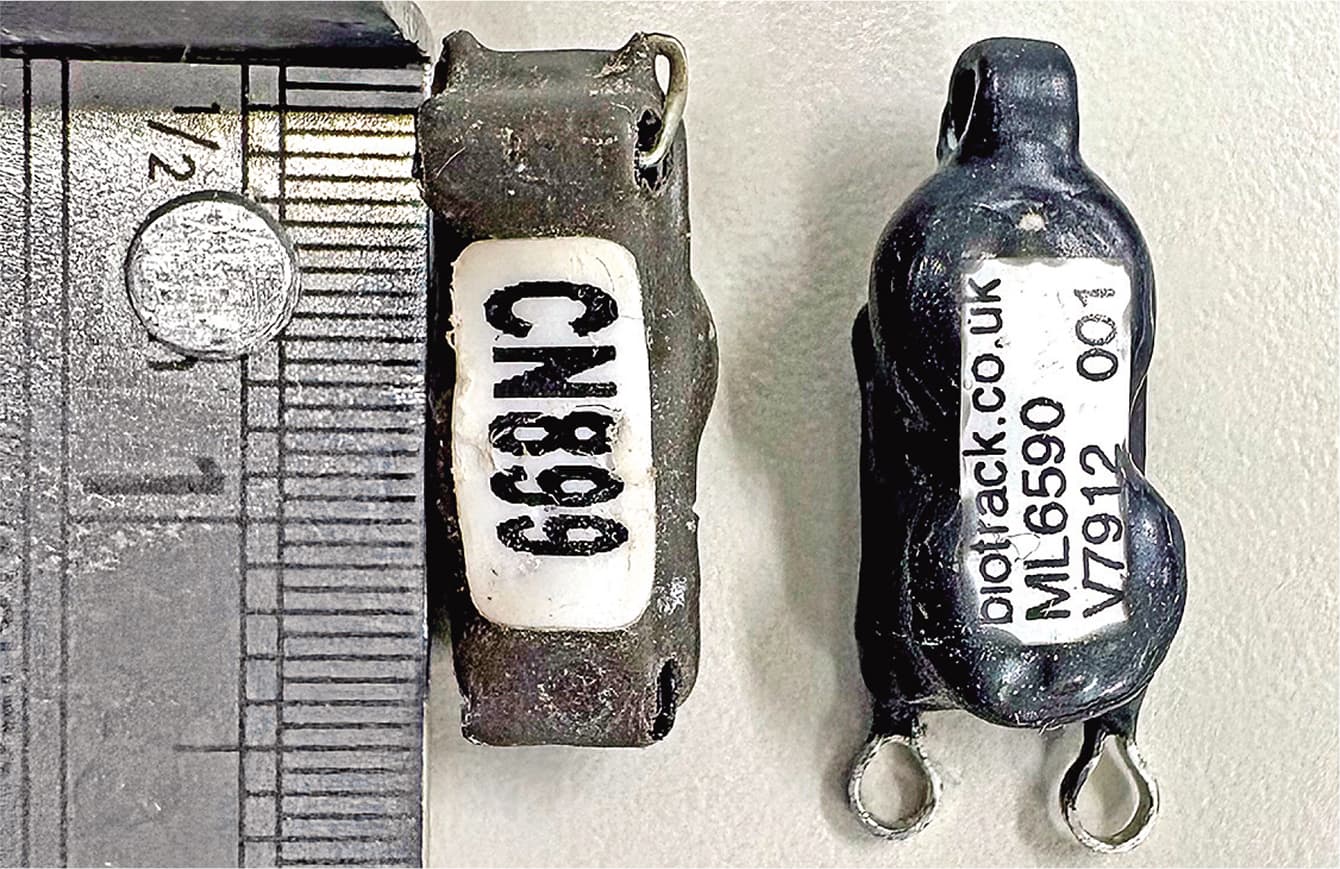
Figure 2. Geolocators used to record routesThese ultra-lightweight geolocators weigh just 0.7 g or so. They are equipped with a sensor that senses light levels; the results can be used to estimate latitude and longitude.
By continuing the survey over several years, we succeeded in tracking all the birds’ migratory pathways in spring and autumn. The results were highly interesting. The individuals to which we fitted the devices made roundtrips between Hokkaido and eastern Australia, but we discovered that their migratory route formed a big figure-eight (Figure 3). In other words, rather than traveling via the shortest route, they took the long way around. Consequently, the total distance traveled over their spring and autumn migrations was somewhere around 40,000 km.
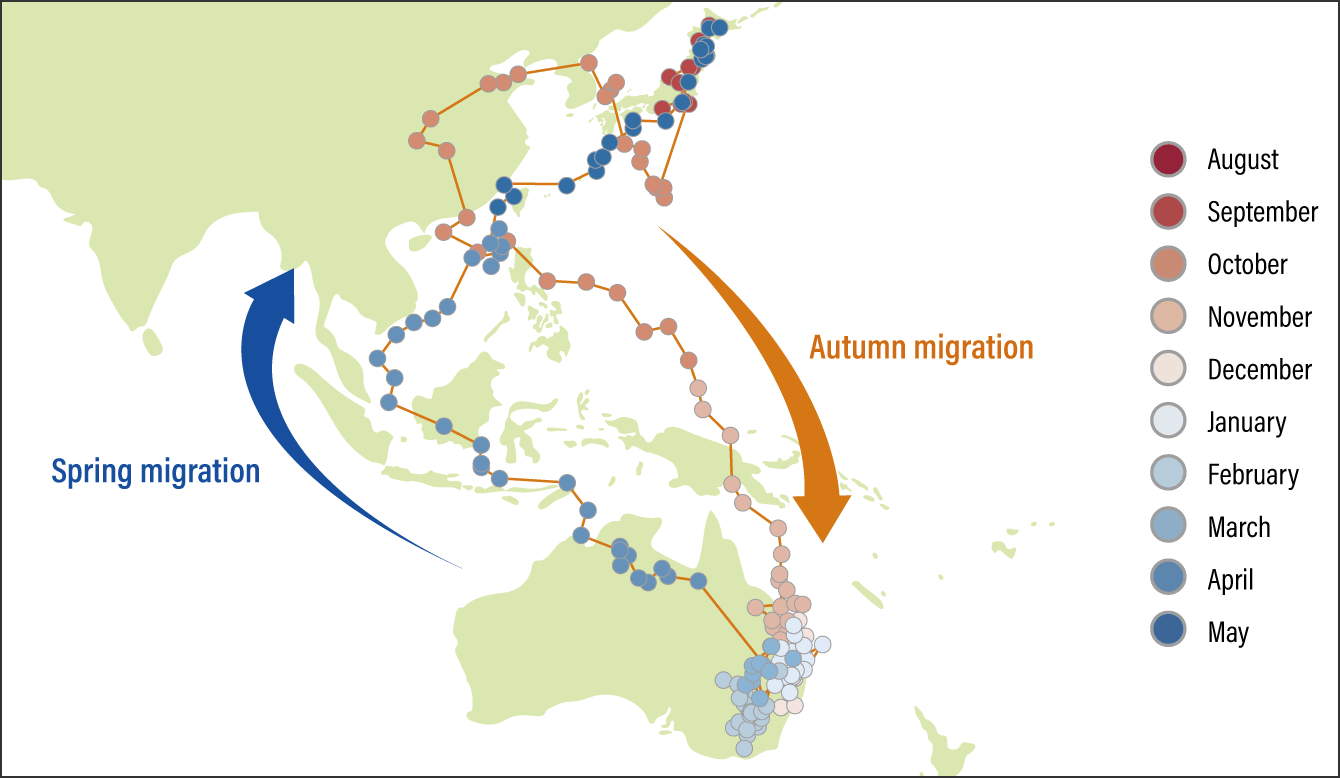
Figure 3. The migratory route of the white-throated needletailDuring the autumn migration, they headed south from their breeding ground in Hokkaido, but then changed course to fly northwest, traveling over the Korean Peninsula and southern China before heading to their wintering spot in Australia. Spreading the word about their highly interesting ecology in the form of their figure-eight migratory route might arouse people’s intellectual curiosity and inspire them to turn their attention to the natural environment.
Having arrived in Hokkaido between late May and June, the white-throated needletails breed and raise their young, before departing again in October, heading south first of all. They then change direction to head northwest, flying north over the Korean Peninsula, and then traveling west. After flying over southern China, they change course to head southeast. They then proceed over the Pacific Ocean and arrive in their wintering spot in eastern Australia. This is the autumn migration.
Why do they migrate in a figure-eight pattern?
During their spring migration, on the other hand, they leave eastern Australia in late March and head northwest. Once over the South China Sea, they change course to head northeast, flying north over the Nansei Islands and the Japanese archipelago before returning to Hokkaido. As their routes differ considerably between their outbound (autumn migration) and return (spring migration) journeys, they form a figure-eight pattern.
Many migratory birds basically migrate between north and south, and some do take detours. Research to date has revealed a number of reasons why birds take roundabout routes. They include being blown off course by the wind, and seeking to avoid dangerous places. For example, factors behind avian detours include places that are hard to cross, such as the Himalayas, and places through which typhoons often pass. We also know that some migratory birds make stopovers to rest in safe places where food is abundant. Thus, migratory routes meander for a number of reasons, but cases in which the round-trip forms a figure-eight pattern are extremely rare, so the article we published attracted a great deal of attention.
We still do not have a clear understanding of why white-throated needletails migrate on a figure-eight route —— that is to say, why they take different routes on their autumn and spring migrations. The reason might be that they take advantage of favorable tailwinds, or that they seek to avoid the impact of typhoons in autumn. Typhoon routes are mostly predictable. As such, avoiding these routes reduces the risks they incur during migration. It may also be related to topography or the distribution of midair food resources. I believe the reasons will gradually become apparent if we continue these surveys.
Generally speaking, tracking the movements of migratory birds is not easy, and the behavior of many species during their migratory periods remains shrouded in mystery. In order to track their movements, we have to trap individuals and attach devices to them. If the recording device is big and heavy, we cannot attach it to small birds that weigh very little. The development of compact, lightweight geolocators in recent years has at last made it possible to conduct tracking studies of small birds as well. White-throated needletails spend virtually all their lives in midair and fly very fast. They are therefore a species that is not easy to observe, not to mention capture, so we encountered all kinds of difficulties before clarifying their migratory route.
One reason why research into white-throated needletails is so important is that their numbers are falling sharply. We know that the number overwintering in Australia has declined by as much as 75% over the last 60 years. Consequently, they are on the Red List of endangered species in a number of Australian cities. The day cannot be far off when they will be placed on that list in Japan, too. That is all the more reason why we need to shed light on both their basic ecology at the breeding grounds and wintering spots that form their regular settlements, and their ecology during their migratory periods.
Rarely attacked by predators while flying
I will now outline a number of facts we know about white-throated needletail ecology at their breeding grounds.
White-throated needletails raise five to six chicks each time they breed. They need a very large tree cavity (a cave-like hollow in a tree trunk or thick branch) to use as a nesting hole. They feed on airborne insects, mainly winged ants. Winged ants fly around in large swarms in the rainy season, so the parent birds catch them and feed them to their chicks. The parents spend just two and a half months raising their young, after which they leave the nest.
Many of these young birds end up being attacked by natural predators upon leaving the nest. They tend to be assailed by small birds in the hawk family. Although the parent birds rarely need to worry about being attacked by predators while flying, thanks to their tremendous speed, they too are sometimes ambushed by natural predators lying in wait for them when they have slowed down to return to the nest or have not yet built up speed when emerging from the nest. They may even be eaten by predators that invade their nests. These are the risks that white-throated needletails incur while raising their young.
We still do not know about their behavior after leaving the nest. While the autumn migration begins after leaving the nest, we have not yet ascertained whether the parents and their young make the journey together. However, these birds often fly in flocks, both at their breeding grounds and at their wintering spots. Some fly in pairs, while flocks may consist of up to 10–20 birds flying together. They are very chatty birds, and observation of flocks of them has shown that they are always calling to each other. They may well be communicating with each other vocally.
It is unclear whether they use any forms of communication other than vocalization, but at excellent feeding grounds where winged ants are swarming en masse, white-throated needletails gather as if from out of nowhere, with as many as 200–300 birds being observed on occasion. It is unlikely that the birds would congregate in such large numbers unless they had flown there from some distance away, beyond visual range, so one has to wonder how they find feeding grounds that temporarily form in midair. Do they have a means of communication, or do they find the insects themselves via some other astonishing method? We have just discovered a clue and are now delving deeper into research on this point.
It is not only their speed in horizontal flight that makes swifts’ flying ability remarkable. They can also ascend to very high locations. According to one article, there is a species that has reached an altitude of 5,115 m. That kind of height is above the clouds, so the birds would not be affected by rain. What is more, as not many birds are likely to be capable of reaching such high altitudes, it might be a safe airspace where they can avoid predators. In addition, the air pressure is lower at higher altitudes, so the birds can achieve higher flight speeds with lower energy consumption. As these birds are living creatures, they do need to overcome obstacles in the form of the low temperatures and very low oxygen concentration at high altitudes, but if they can do that, flying at this kind of height during long-distance migrations would have the advantages of reducing the time required and conserving energy. In the case of white-throated needletails, we are still gathering and analyzing data from when they are flying, but once we have completed our data analysis, we hope that the altitudes at which they travel will become clear.
We are also yet to identify the factors contributing to falling numbers. One conceivable major factor is deforestation caused by humans. White-throated needletails need big tree cavities in which to breed. In Hokkaido and northern Honshu, the felling of forests has reduced the number of trees in which such tree cavities can form, so it is likely that there are fewer places in which the birds can nest.
Severely impacted by climate change
Although that level of major environmental change has not been observed in their wintering spot in Australia, recent years have seen frequent large-scale forest fires, which might be having an impact. Environmental changes along their migratory routes are also a key factor. As we have not established their behavior during their migration, we cannot make any categorical assertions, but in the case of white-throated needletails, we feel it is highly likely that they eat small insects in midair while migrating. In Southeast Asia, which is on their migratory route, the area covered by forest is declining substantially. We also have to examine the possibility that if the birds cannot get enough food during their journey, they will be unable to get sufficient nutrients and will not be able to complete their migration.
The impact of global warming must be considered, as well. Not only white-throated needletails, but migratory birds in general are believed to be experiencing major impacts from changing wind directions due to climate change. These wind changes mean migration takes several days longer, which results in birds being unable to reach their breeding grounds at the optimal time of year. This kind of situation could well be occurring. Recent years have also seen changes in typhoon frequency, timing, and routes. It might be that, having established the timing and routes of their migration so as to avoid typhoons as far as possible, birds are now encountering them midway through their migration, due to climate change.
Migratory birds travel long distances from their wintering spots in order to breed in the most favorable environment in spring. They need to time the start of their journey correctly, so they can arrive at their breeding grounds at the best time for breeding (Figure 4). Either after finding a mate or with an existing one, they pair up, lay eggs at the appropriate time, incubate the eggs until they hatch, and then raise their chicks. In the case of white-throated needletails, they will be unable to provide their chicks with sufficient food if they do not time their chicks’ growth period to coincide with the time when there are plenty of winged ants. The birds arrive at their breeding grounds at a time that ensures their chicks’ growth period corresponds with the time when food is plentiful. They calculate back from this to determine when to set off from their wintering spots. In order to arrive in Hokkaido between late May and June, they depart from Australia in late March or thereabouts. They do not consciously think about this; it is programmed into them by evolution. Once the time comes when they need to depart, their hormonal balance changes and the migratory impulse occurs. Then the birds fly off, one after another.

Figure 4. A year in the life of a white-throated needletailThe birds arrive in Hokkaido during the rainy season, when winged ants emerge in their masses, and breed and raise their young there. The migratory impulse is programmed into them, so that they depart from their wintering spots in time to arrive for the rainy season.
Even once they have set off, the deterioration of the natural environment at stopover sites and wind changes caused by climate change could well make migration harder. In addition, there is the concern that warming is causing the seasons to change earlier at their breeding grounds, and that the time when winged ants are most prevalent is now earlier than originally expected, and therefore occurs before the chicks’ growth period. Although the migratory route has only just emerged, we hope that this research will contribute to the identification of the factors contributing to the decline of the white-throated needletail and the formulation of conservation methods.







